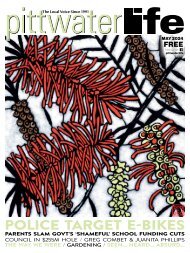Pittwater Life November 2018 Issue
Coming to Your Rescue. Missing 'Link'. Offleash Dog Trial. Wonders of Science. Market Month!
Coming to Your Rescue. Missing 'Link'. Offleash Dog Trial. Wonders of Science. Market Month!
You also want an ePaper? Increase the reach of your titles
YUMPU automatically turns print PDFs into web optimized ePapers that Google loves.
Spice things<br />
up with<br />
turmeric<br />
Not only is turmeric great for<br />
aches and pains, arthritis and<br />
rheumatism, it is a delightfully<br />
decorative plant in the garden.<br />
Turmeric is a member of the<br />
ginger family, native to India and<br />
Pakistan.<br />
The attractive, tall, bright<br />
green leaves that can grow up<br />
to a metre in height, are perfectly complemented by<br />
the spikes of pure white flowers that can be tinged with pink.<br />
Turmeric grows from knotty rhizomes under the ground.<br />
The new growth appears every spring and then dies down<br />
in winter. This is when the spice can be harvested. The orange<br />
rhizomes can be used freshly grated or in a dried, powdered<br />
form. It is used extensively in curries as a spice, for colouring<br />
dye and as a tea for aches and pains.<br />
Turmeric is easy to grow in warm humid conditions. Plant the<br />
rhizomes (I got mine from a fresh vegetable organic health food<br />
shop) in good, rich soil that drains well. The plants love plenty<br />
of water – but not ‘wet feet’.<br />
Their natural habitat is dappled light at the edge of subtropical<br />
rain forests. The plants will grow in full shade but will<br />
produce a higher yield with some sunlight.<br />
If space is a problem, turmeric makes a very attractive pot<br />
plant indoors, in a sunny window, or grown outside.<br />
Flannel flowers:<br />
short but so sweet<br />
The soft, velvety flowers of<br />
the native Flannel flowers<br />
appear every year in late spring<br />
along the road sides, from<br />
crevices in the rocky kerbs and<br />
in the stony soil under the gum<br />
trees in the bush.<br />
Flannel flowers are shortliving<br />
plants, lasting just a<br />
couple of years. Seeds are<br />
hard to find and germinate<br />
erratically, but established<br />
plants are in garden centres,<br />
potted. These amazing silver/<br />
grey native plants love full sun<br />
or semi-shade; they will grow in<br />
any well-drained soil (they hate<br />
‘wet feet’).<br />
If your garden is damp or<br />
your soil is heavy clay, they<br />
will suffer from root problems<br />
and fungal disease. You will<br />
have to mound up the soil with<br />
additional sand; or better still,<br />
grow them in pots.<br />
They don’t need native<br />
potting mix – any good potting<br />
mix will do. When planting,<br />
remove the plants from their<br />
pot very carefully with as little<br />
disturbance to the root ball as<br />
possible. Flannel flowers hate<br />
their roots to be disturbed.<br />
Make sure you tip-prune the<br />
plants on a regular basis to<br />
keep them bushy. The more<br />
tips, the more flowers you<br />
will get. Water them in with a<br />
seaweed solution at the time of<br />
planting, and feed with a waterbased<br />
fertiliser every three or<br />
four weeks. (Eco-Aminogrow<br />
is an organic fertiliser that is<br />
great for native plants.)<br />
Garden <strong>Life</strong><br />
The Local Voice Since 1991<br />
NOVEMBER <strong>2018</strong> 69

















